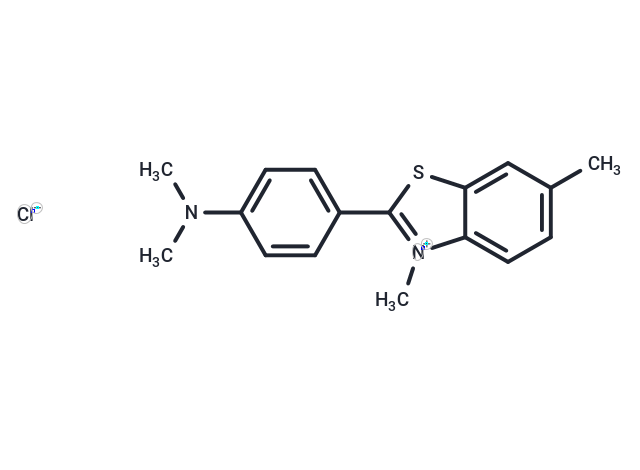Shopping Cart
- Remove All
 Your shopping cart is currently empty
Your shopping cart is currently empty

Thioflavin T (Basic Yellow 1) is a widely used dye for visualizing and is a cationic Benzothiazole dye that shows enhanced fluorescence upon binding to amyloid in tissue sections.

| Pack Size | Price | Availability | Quantity |
|---|---|---|---|
| 1 g | $29 | In Stock | |
| 1 mL x 10 mM (in DMSO) | $29 | In Stock |
| Description | Thioflavin T (Basic Yellow 1) is a widely used dye for visualizing and is a cationic Benzothiazole dye that shows enhanced fluorescence upon binding to amyloid in tissue sections. |
| In vitro | Thioflavin T (ThT), a benzothiazole dye, notably increases in fluorescence when bound to amyloid fibrils, facilitating their diagnosis both ex vivo and in vitro. This fluorescence enhancement is influenced by micelle formation, with ThT micelles—measuring about 3 nm in diameter—visually confirmed along fibrils using atomic force microscopy. These ThT micelles bind to amyloid fibrils, significantly enhancing fluorescence emission. In aqueous solutions at concentrations typical for fluorescence assays (~10-20 μM), ThT exists as micelles, with its critical micellar concentration determined to be 4.0±0.5 μM. As ThT concentration rises above this threshold, more micelles are observed binding along the amyloid fibrils. However, at low pH, ThT micelle formation is disrupted, and fluorescence enhancement upon binding to amyloid fibrils decreases several-fold, especially below pH 3. |
| Alias | Basic Yellow 1 |
| Molecular Weight | 318.86 |
| Formula | C17H19ClN2S |
| Cas No. | 2390-54-7 |
| Smiles | [Cl-].CN(C)c1ccc(cc1)-c1sc2cc(C)ccc2[n+]1C |
| Relative Density. | 1.301 g/cm3 at 20℃ |
| Storage | Powder: -20°C for 3 years | In solvent: -80°C for 1 year | Shipping with blue ice. | ||||||||||||||||||||||||||||||||||||||||
| Solubility Information | H2O: 12.5 mg/mL (39.20 mM), Sonication is recommended. DMSO: 50 mg/mL (156.81 mM), Sonication is recommended. | ||||||||||||||||||||||||||||||||||||||||
Solution Preparation Table | |||||||||||||||||||||||||||||||||||||||||
H2O/DMSO
DMSO
| |||||||||||||||||||||||||||||||||||||||||

Copyright © 2015-2025 TargetMol Chemicals Inc. All Rights Reserved.